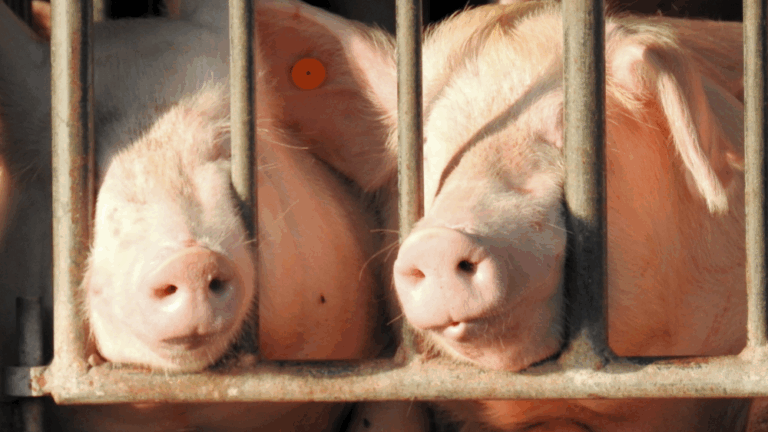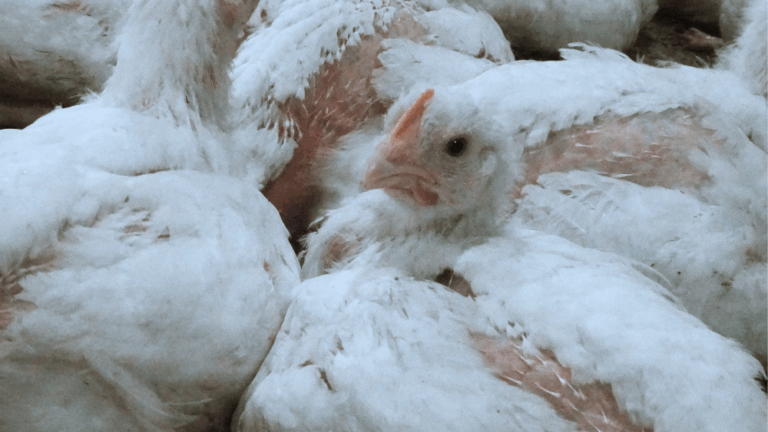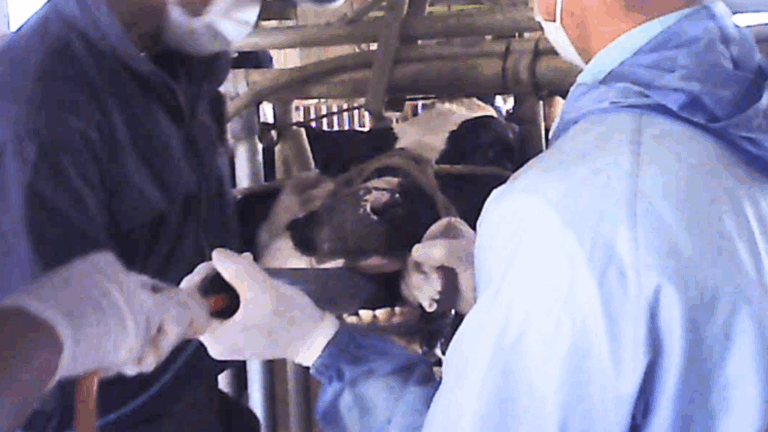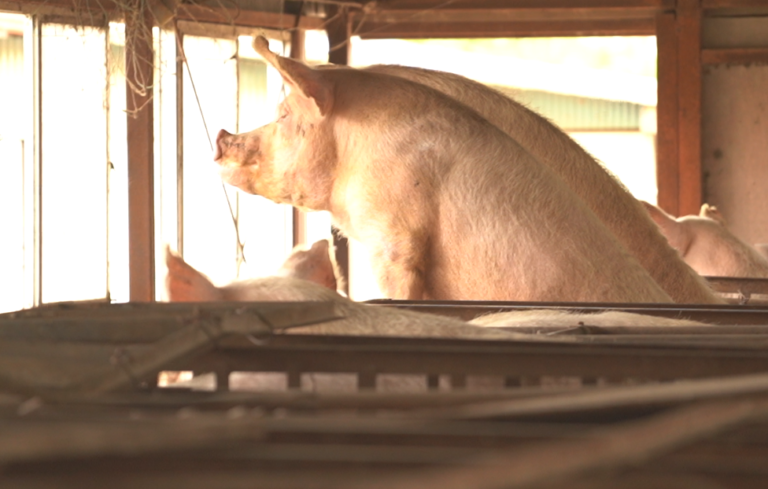Since it occurred at a pig farm in Japan in September 2018, classical swine fever has no sign of stopping. So far, the infection in pig farms has spread to 14 prefectures, and a total of 231,895 pigs have been depopulated (as of the end of April 2021). With avian flu, 9,689,703 birds were depopulated in the country from 2020 to 2021, and it was mentioned in these articles (1, 2) that this depopulation was not euthanasia. Depopulation for swine fever is also far from euthanasia. Pigs are killed by “disinfectant injection into the heart”, “electric killing”, or “carbon dioxide gas killing.”
Use of disinfectant “Pakoma”
On 2021/4/19, Mainichi Newspaper published an article with the title “Piglet during swine fever depopulation goes wild, a prefectural employee stabbed by an injection needle“. The following is a partial quote from the article.
It was announced that a male prefectural employee performing depopulation was stabbed in the leg by an injection needle containing a disinfectant used for slaughter.
The article writes this casually, but using disinfectants as a slaughter method is abnormal. It is not recognized in veterinary science and disinfectants are not designed as slaughter drugs in the first place.
Strychnine, nicotine, insulin, caffeine, cleaning agents, solvents, pesticides, disinfectants, and other toxicants not specifically designed for therapeutic or euthanasia use are unacceptable for use as euthanasia agents under any circumstances.
AVMA Guidelines for the Euthanasia of Animals:2020 Edition
The disinfectant used for slaughter is usually the inverted soap “Pakoma”. The disinfectant Pakoma is used not only as a slaughter agent in the event of livestock infectious diseases like foot-and-mouth disease and classical swine fever. Pigs with a negative impact on productivity, such as being too small, diarrhea not stopping, and respiratory diseases, are slaughtered at pig farms, but the disinfectant Pakoma is also commonly used in such cases.
A piglet who has been injected with Pakoma at the heart will stop moving in a few seconds to 30 seconds. Some people call this “quick death,” but that is not the case. Not moving does not mean dead. The pigs may be suffering from suffocation.
Moreover, it is not always possible to administer the drug without missing the heart. When the needle misses the heart, the pigs gasp as if trying to get any air, spit blood, flutter their whole bodies, and keep moving for about 5 minutes.
We have never heard of slaughter with disinfectants overseas, so it may be a method peculiar to Japan. This disinfectant “Pakoma” was also used during the 2010 foot-and-mouth disease. Many animal protection groups have called for the abolition of disinfectant use as an inhumane method of slaughter. However, even with classical swine fever in Japan that has continued to occur since 2018, this disinfectant Pakoma is still being used.
Use of disinfectant (Pakoma) for swine fever depopulation since 2018
| Local governments that injected Pakoma into pig hearts without anesthesia for piglet depopulation: 5 out of 14 prefectures (2 out of 14 had no piglet depopulation. One of the 5 prefectures that injected Pakoma without anesthesia discontinued after the incident of a person being stabbed by the injection needle) |
| Local governments that injected disinfectants (Pakoma) into the heart after electrocution for slaughter of large pigs like fattening pigs and breeding sows 11 out of 14 prefectures (6 always administer Pakoma after electrocution, 5 use Pakoma only when they cannot die after electrocution) |
It’s out of the question to inject disinfectant into the heart without anesthesia, but what about injecting the disinfectant Pakoma after electrocution? Usually, in electric killing, electricity is applied to the head to lose consciousness → and then to the chest to cause cardiac arrest. However, there are pigs who cannot die even with that procedure. In addition, some local governments inject Pakoma into the heart after applying electricity only to the head to lose consciousness. In these cases, the question is whether the action of the disinfectant Pakoma can cause the pigs to die while they are unconscious, but the duration of the consciousness loss due to the electric shocks is not long. Depending on the situation, such as how much current can be passed in the correct place, whether the current can pass for at least 4 seconds*, and whether a well-maintained electrode is used, the time from consciousness loss due to electric shocks to recovery is said to be 30-60 seconds1. This means that the pig must be killed by injecting Pakoma into the heart within 30 seconds after loss of consciousness, but as mentioned above, it is totally unknown by what mechanism of action and in what time the disinfectant Pakoma causes the pig to die. Pigs may have experienced the double suffering of the pain of electrocution, followed by suffocation from the disinfectant Pakoma.
1Electrical Stunning of Red Meat Animals Stun Duration
Unable to die, pigs struggle in flexible container bags
The following text is taken from an article titled “CSF culling 80% complete in Maebashi. Tension burdens the mind as well”.
Until now, piglets were mainly placed in sandbags, and it was rare to see the carcasses directly. Still, the culling is inadequate, and some piglets struggle as they get buried. During work, filth goes into the eyes, too. In the future, even larger pigs will be handled, but they say they’ll ask the prefecture to put them in bags as much as possible to reduce the mental burden on the workers.
When we asked the local government what happened to these piglets who were moving at the time of burial, they said that they had injected Pakoma and buried them.
“Guidelines for the prevention of epidemics of specific livestock infectious diseases related to classical swine fever published on 2020/7/1 by the Agriculture Minister” provide a guideline for incineration and burial, and demand prompt depopulation for early containment of infectious diseases. This is not possible in cases with over 5,000 animals, but it still has to be done as quickly as possible. Since 2018, 14 farms have performed large-scale depopulation of over 5,000 pigs due to classical swine fever. Perhaps there were quite a few “pigs who couldn’t die” on these large farms, where inexperienced defense force personnel were dispatched for rapid depopulation.
Methods of confirming death in classical swine fever depopulation since 2018
| Methods of confirming death for large pigs, like fattening pigs and breeding sows | Out of 14 prefectures: – Check pupils, eyelids, and corneal reflex for each animal: 11 – Judgement only by whether they move or not: 2 – Check pulsation, pupils, eyelids, and corneal reflex one by one: 1 |
| Method of confirming death for piglets | Out of 14 prefectures: – Check pupils, eyelids, and corneal reflex for each animal: 6 – Judgement only by whether they move or not: 5 – Check pupils, eyelids, and corneal reflex by sampling: 1 (2 out of the 14 prefectures had no piglet depopulation.) |
In order not to incinerate alive, it is necessary to confirm that death, and for that purpose, it is necessary to evaluate the following items for each pig.
– Body movements: Complete loss of muscle tone leads to relaxed body of the animal
Reference: EFSA Panel on Animal Health and Welfare (AHAW) Welfare of pigs during killing for purposes other than slaughter First published: 20 July 2020 https://doi.org/10.2903/j.efsa.2020.6195
– Absence of breathing
– Absence of response to palpebral and corneal stimuli
– Heartbeat: Measure heartbeat using palpation or auscultation
– Pupil size: Dilated pupils (mydriasis) is an indicator of death, the assessment of which requires close examination of the eyes
However, only one prefecture in Japan makes a similar evaluation at the time of depopulation for classical swine fever (prefecture that “check pulsation, pupils, eyelids, and corneal reflexes one by one”).
In the case of piglets, if they are killed together by gas killing in a container, it takes time to check each piglet. As such, 40% of local governments judge only by “moving or not moving” that can be checked superficially. However, it is not possible to judge death only by moving or not moving, and with only the evaluation of the eyes, the consequence is irreversible if the evaluation is wrong. The only way to ensure death is to perform the series of evaluations mentioned above, even if it takes time.
Repeated electric shocks required to get them to collapse. Resounding screams.
Twitter post by a person who visited the site of classical swine fever depopulation(2021/4/26):
“They had to do the electric shock (electrocution) of the parent pigs many times before they collapsed, and we heard a scream each time. Seeing the interactions between the pigs and the workers, my heart ached.」
The electric killing is performed by sandwiching the pig’s head with scissors-shaped tongs and applying current to lose consciousness → then applying current to the chest to stop the heart. If the current is applied successfully to the head, the pig will immediately collapse and lose consciousness. Of course, if consciousness can be lost, they won’t scream. Vocalization is a clear sign of consciousness (Note: they may be conscious even if they are not vocalizing). However, when current is applied without loss of consciousness, the pigs scream and flutter on the ground and suffer.
Inquiries to prefectures revealed that in fact, parent pigs (mother pigs raised to give birth to children) are unable to reach loss of consciousness with a single electrocution.
There are several possible reasons.
- The electrodes have not been placed on the right spots. To lose consciousness, pigs need to be restrained to place electrodes on the correct spots of their heads, but it is difficult to restrain them in pig farms not designed for slaughter. It takes 4 seconds* (at least 3 seconds) to apply current. Whether or not immediate loss of consciousness can be achieved depends largely on the skill of the workers, but there are no skilled people among the workers temporarily gathered for the swine fever depopulation.
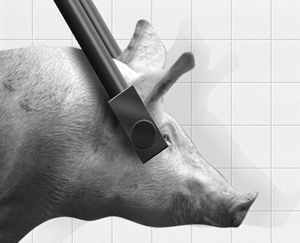
The correct position of the electrode is as in the photo above. When it is difficult to get this position, an alternative is the position as in the photo below.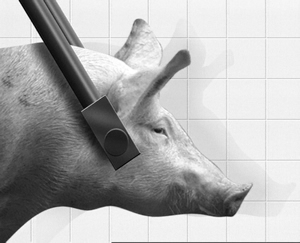
Photo below: the correct place to pinch on both sides: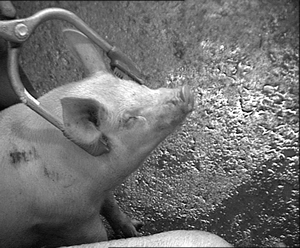
Photos from: Electrical Stunning of Red Meat Animals Humane Slaughter Association (The link includes videos as well.) - Insufficient current due to inadequate maintenance such as dirty electrodes or damaged cables
- Pigs are dehydrated, unable to effectively reach unconsciousness
- The amount of current is not enough for the size of the pig
No sedatives or anesthetics used
The depopulation for classical swine fever is not a slaughter for “meat”, but a slaughter to bury and incinerate pigs, so any amount of sedatives or anesthetics could be used. The “Guidelines for the Prevention of Epidemics of Specified Livestock Infectious Diseases Concerning Classical Swine Fever” published on 2020/7/1 by the Minister of Agriculture, Forestry and Fisheries” also says “Give consideration from the viewpoint of animal welfare as much as possible, such as using sedatives or anesthetics”. However, their use is infrequent.
Use of sedatives and anesthetics for classical swine fever depopulation since 2018
| Sedatives | 5 out of 14 prefectures (Of which one uses it only when there are excited pigs; three use it not for all pigs, but to the extent possible) |
| Anesthetics | 0 out of 14 prefectures |
From the viewpoint of animal welfare, some prefectures instructed to inject sedatives before the electric killing, but most local governments did not use it. No prefecture used anesthetics. To perform depopulation with as little pain as possible, sedatives and anesthetics should be given before lethal work. However, it should be remembered that the work of restraining pigs for injection takes time unless they are skilled people, and if it takes time, the restraining procedure itself can be very stressful for pigs.
CO2 gas killing
In the case of small pigs, carbon dioxide gas killing was performed in addition to the method of injecting Pakoma into the heart. CO2 gas killing was carried out in all municipalities that depopulated small pigs, but how cruel it is can be seen in this video released in 2018. PIG SLAUGHTER SCANDAL- Why Carbon Dioxide Is The Real Welfare Problem, Not The Shortage
It should be noted that the location of this video is a slaughterhouse, and carbon dioxide gas slaughter is performed by a specialized machine whose gas concentration, exposure time, etc. are controlled. Still, this is the situation. In swine fever depopulation in Japan, it is performed with make-shift methods like with containers and tarps, or if there are no convenient containers, the truck beds are lined with plywood. One municipal official said “With carbon dioxide, too, it takes time to die and they suffer”. Changing from Pakoma injection to the heart to CO2 does not solve the issue.
What we can do
Livestock animals are not given the option of “euthanasia”. They are trapped all their lives and are denied freedom, and at the end they struggle and die. The workers who are taken to the scene are not performing depopulation because they like it, either. The task of killing animals is emotionally difficult and painful for anyone. Even among vaccinated pigs, classical swine fever occurs. In May, CSF occurred again at a farm in Japan. Who knows when these slaughters will end. Foot-and-mouth disease settles down, and then the CSF. Even if CSF subsides, the next one will come again. The only way to end it is to look at the fundamental problems of the livestock industry. The ultimate solution is to stop the habit of eating meat. In the first place, nutritionally meat is not necessary.
- Tell people around you about the cruel reality behind the livestock industry and let them know that we have the option of not eating
Since depopulation due to livestock infectious diseases will continue, it is also important to reach out to relevant offices. How are the pigs killed, why can’t they be killed painlessly, are there any animals buried alive? What goes on on in closed farms, we can hardly know.
- Ask MAFF and prefectures about what bothers you and demand improvement
It is each of us citizens who pays for these depopulation costs. We have the right to know, and the obligation to keep the pigs from suffering as much as possible.
*On-farm killing of pigsEURCAW-Pigs Regional meeting East17 November 2020Inga Wilk©FLI©FLI
Electric Stunning of Pigs and Sheep by Temple Grandin Colorado State University (Updated January 2020)



